Captivating Coral: The Joy Of Coral Jewelry
The beauty, history, and symbolism of this classic, radiant red 'gemstone'
When it comes to historical jewelry, coral has been especially beloved throughout history for its brilliant color, malleability, and symbolism. And the most famous is the vivid red Italian coral that grows in the Mediterranean. It’s also one of my favorite ‘gemstones’ in jewelry! For the second installment of The Jewelry Casket, let’s talk about the captivating jewel that is coral throughout the ages, andiamo!

An Ancient Amulet
We call it a ‘gemstone,’ but coral is actually a soft, organic material created from the skeleton of polyps found underneath the ocean. The colors of coral range from soft orange to vivid red, salmon, and pale pink. It’s easy to shape and work with and has been used in jewelry since ancient times.
In ancient Rome, it was believed that wearing Italian red coral warded off the evil eye, bad luck, and disease! Children and infants in Rome were often gifted necklaces with branches of brilliant red coral that served as protective amulets. Pliny the Elder, the ancient Roman author and scholar, stated that “Branches of coral, hung at the neck of infants are thought to act as a preservative against danger.”1


It was also believed that coral had medicinal properties, “Calcined, pulverized, and taken in water, coral gives relief to patients suffering from griping pains in the bowels, affections of the bladder, and urinary calculi.”2 It was also added to wine and described to alleviate symptoms of fever, and improve blood circulation. Although I definitely wouldn’t advise doing this!
The tradition of giving children strands of red coral for protection continues to this day! Paintings from the Late Medieval and Renaissance periods often depict the Christ Child holding or wearing beaded coral necklaces similar to rosaries. Coral was also used as a teething aid for young children.
Interestingly, branches of coral have been compared to the human circulatory system, imitating the branching appearance of blood vessels in the body. While coral does NOT contain a “true” circulatory system due to the lack of a heart and blood vessels, their gastrovascular cavities act like a “circulatory system” because they help transport nutrients throughout the organism.3 This is one of those moments when you think about how incredible and intentional nature is!

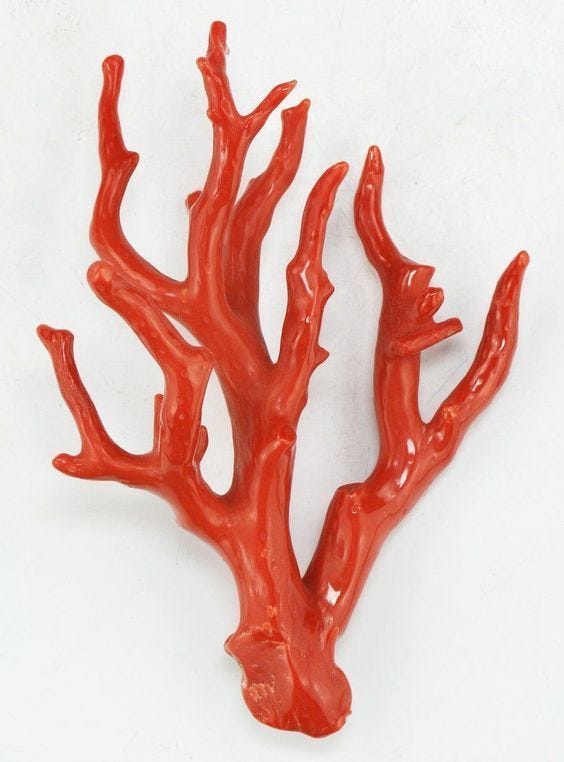
Myth & Magic
Coral also appears in Greek mythology! Perseus, after killing Cetus the sea monster with Medusa’s head, places it on the riverbank while he washed his hands. When he picked it up, her blood had turned the surrounding plants and stones into red coral! Since her gaze had the power to petrify men, her blood also carried this potent power.4
The hero washes his victorious hands in water newly taken from the sea:
but lest the sand upon the shore might harm the viper-covered head, he first prepared
a bed of springy leaves, on which he threw weeds of the sea, produced beneath the waves.
On them he laid Medusa's awful face…and the living weeds, fresh taken from the boundless deep, imbibed the monster's poison in their spongy pith: they hardened at the touch, and felt in branch and leaf unwonted stiffness….Even from that day the coral has retained such wondrous nature, that exposed to air it hardens.—Thus, a plant beneath the waves becomes a stone when taken from the sea.5
In Hindu mythology, red coral is associated with the god of war and courage, Mangal, the counterpart of the god Mars/Ares. It is said to enhance the wearer’s vitality and courage as a result. Several beautiful examples of coral jewelry from Nepal exist at The Metropolitan Museum of Art, created with turquoise, silver, and other precious materials! In Chinese culture, coral jewelry was regarded as something that could prolong the wearer’s life.6 And Arab physicians in the 11th century thought coral to produce good humor in a person as well.7
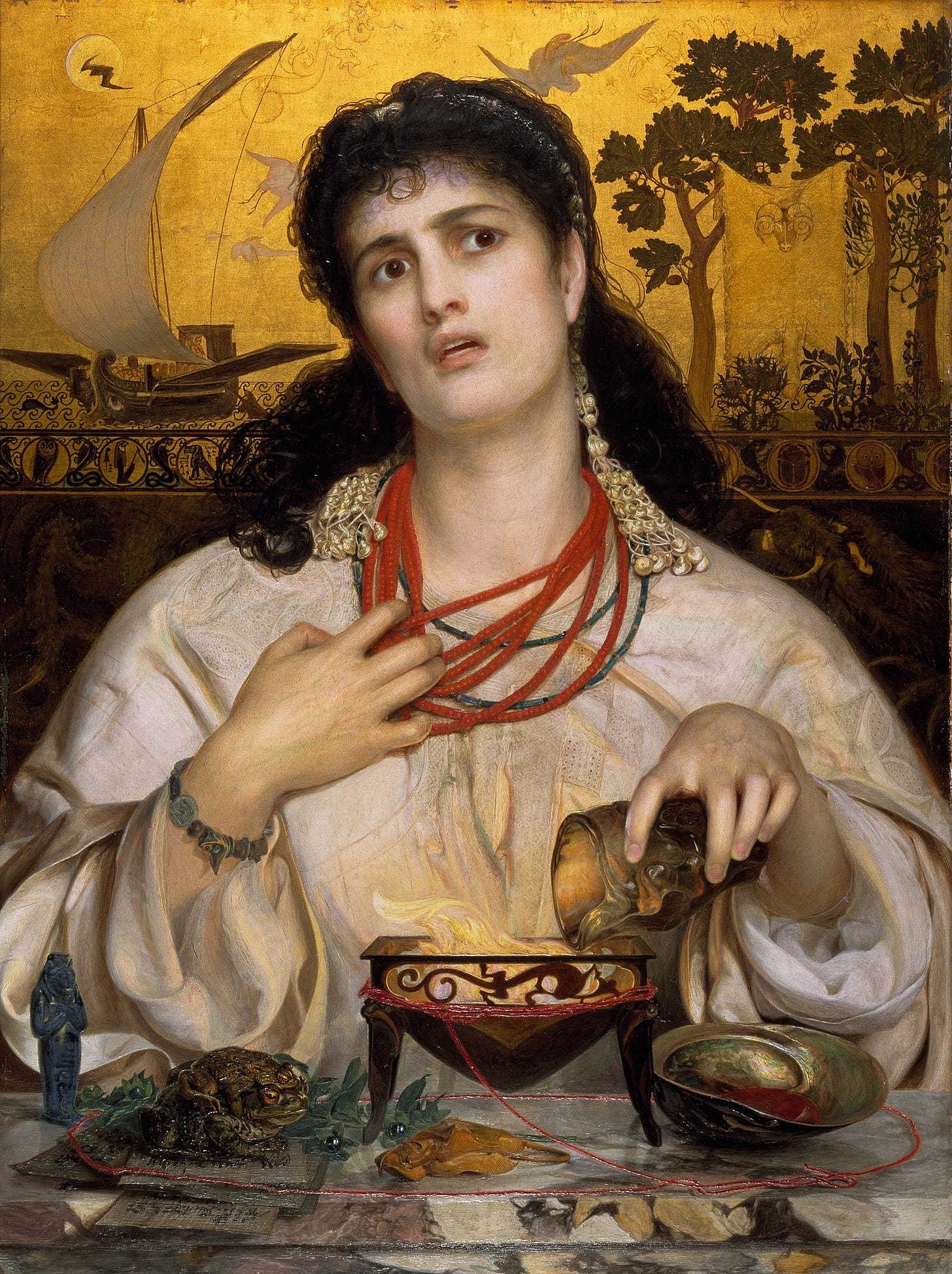
Although coral is not directly mentioned in the original myth, in Frederick Sandys’ painting Medea (1866-1868), the multiple strands of beaded coral that the titular character wears serve a symbolic purpose. In Greek mythology, Medea was a beautiful princess and sorceress, the daughter of the King of Colchis and the niece of the witch Circe. The story goes that Medea fell in love with Jason who came in search of the Golden Fleece. They married and had two children. However, Jason later abandoned her to marry the princess Glauce. Greek myths are so romantic.
In revenge, Medea killed Glauce and murdered her two children in front of him. In the painting, Medea is shown casting the spell to kill Glauce with a dress that bursts into flames (because why not?!) She is pulling her coral necklace viciously – a stone thought to protect children from evil – as her hatred drowns out any maternal love she has for her children.
Coral Jewelry In the Georgian & Regency Periods
First, a little bit of clarity on these terms: Georgian and Regency tend to be used interchangeably when, in fact, they correspond to slightly different points in time. The Georgian era spans the years from 1714 to 1837, named as such after the reigns of King George I, II, III, and IV. The Regency period spans only 9 years, from 1811 to 1820, and refers to Parliament’s Regency Act of 1811. This act appointed King George III’s (aka “Mad King George”) eldest son as Prince Regent. Regent = Regency.
In 1820 King George III died and his son became known as King George IV. It may seem picky, but the Regency is seen as a sub-period by historians within the larger Georgian era, which culminates in 1837 when Queen Victoria was crowned, thus beginning the Victorian era.
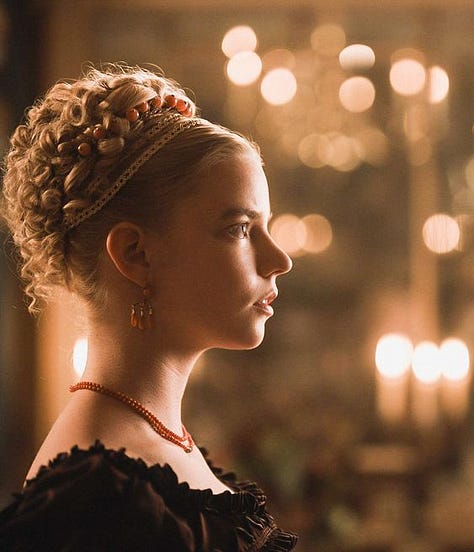
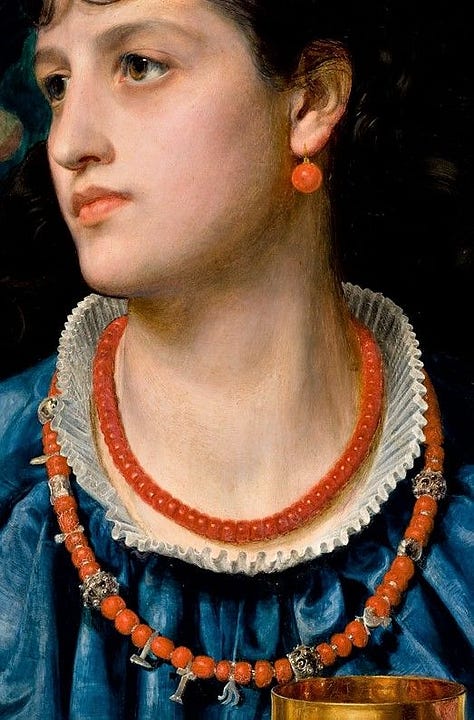
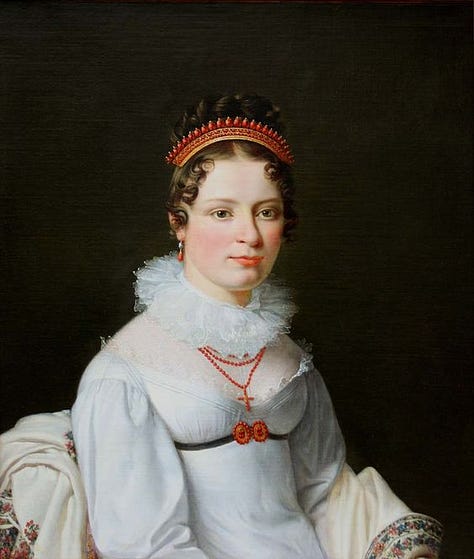
Now back to jewelry! Coral jewelry continued to be used during the Georgian era and throughout the Victorian period. Most 18th and 19th-century portraits of women showcase the beautiful assortment of coral jewelry they commonly wore. Whether carved into simple beads or elaborate cameos, coral was worn as necklaces, bracelets, earrings, brooches, elaborate diadems, and simple pins.
One of the reasons why I love the 2020 version of Emma by director Autumn de Wilde, is the sheer beauty of the fashion! Emma often wears coral jewelry throughout the film, including this stunning dinner look (above) where she wears a coral diadem, a double-stranded coral bead necklace, and drop earrings with three hanging pendants. When compared to portraits of women from around the same period, it’s easy to see how the film isn’t far off from historical accuracy. Coral was one of the few accessories that could be worn appropriately during the day, as well as the evening.

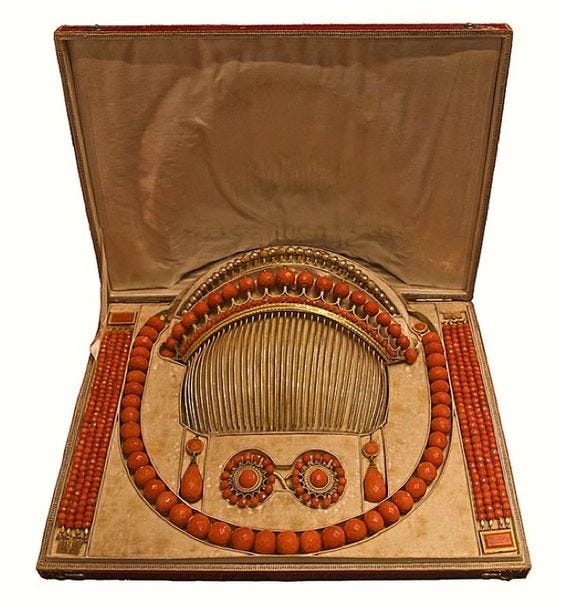
By the 19th century, coral was no longer believed to be a protective talisman. However, it remained a popular christening gift just the same. Little girls would receive beaded necklaces while boys were given coral rattles that also functioned as teething aids. The sheer amount of paintings of women wearing coral is truly a testament to its popularity and availability. And it’s easy to see why. The brilliant red adds the right touch of vivacity and brightness to any portrait, drawing the eye and denoting beauty and class.
Thank you for reading my musings and ramblings! If you liked this post please hit that <3 button and subscribe for more!
Pliny the Elder, The Natural History, Book 32, Chapter 11. John Bostock, M.D., F.R.S. H.T. Riley, Esq., B.A. London. Taylor and Francis, Red Lion Court, Fleet Street. 1855. Perseus Tufts.
Pliny the Elder, “The Natural History,” Book 32, Chapter 11. Perseus Tufts.
Organismal Biology Course, “Animal Circulatory Systems,” Georgia Institute of Technology, Georgia Tech Biological Sciences.
Ovid, The Metamorphoses, Book 4, Lines 604-705, Brookes More, Boston, Cornhill Publishing Co. 1922. Perseus Tufts.
Ovid, “Metamorphoses,” Book 4, Lines 706ff. Perseus Tufts.
Sophie McConnell, Metropolitan Jewelry, 1991, Metropolitan Museum of Art, New York, NY, pg. 23.
Sophie McConnell, “Metropolitan Jewelry,” 23.





So interesting, thank you so much
Love the wide-reaching history of this material! I need to add coral to my jewelry collection.